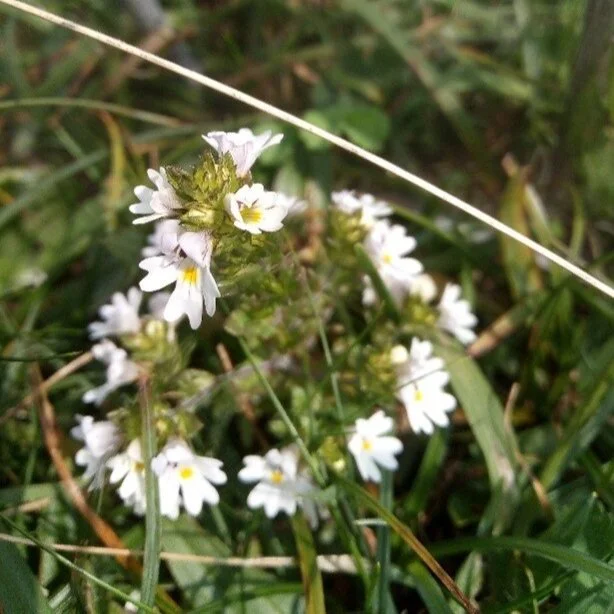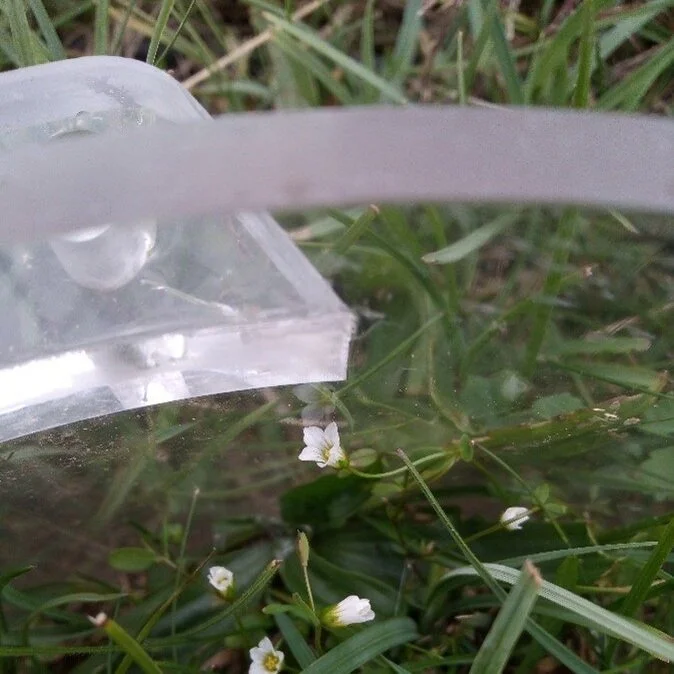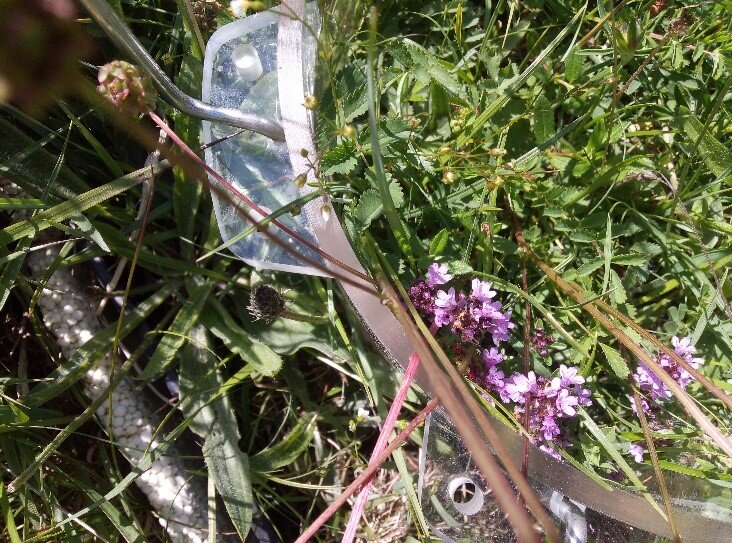eyebright (EUPHRASIA OFFICINALIS), COMMONLY FOUND ON CALCAREOUS GRASSLAND
FAIRY FLAX (LINUM CATHERTICUM), COMMON TO CALCAREOUS GRASSLAND
WARDLOW HAY COP (SUMMIT)
GARETH PHOENIX, PRINCIPAL INVESTIGATOR FOR THE WARDLOW LONG-TERM EXPERIMENT
BLOCK OF ELEVATED CO₂ MESOCOSMS
block of ambient CO₂ mesocosms in situ at the field site, MARKED WITH NUTRIENT CODES (Blue text represents calcareous grasslands, red is acidic grasslands)
CALCAREOUS MESOCOSM PRIOR TO BEING SURVEYED
WILD THYME (THYMUS PRAECOX)
BACKGROUND
The concentration of CO₂ in the atmosphere is higher now than at any other point in human history. This is the primary contributor toward the planet’s current climate crisis and a key driver of the sixth, human-driven, mass extinction event. However, CO₂ is also ‘plant food’, and is an essential component of the carbon cycle that drives the majority of life on earth. As CO₂ increases, so does the rate at which it is removed from the atmosphere. This is termed a negative feedback loop, and provides perhaps one of the only climate ‘good news’ stories there is. In fact, it may represent one of the most important tools we have in our fight against rapid climate change. So we needn’t worry, right?
Not exactly. As with everything in science, things are more complicated than they might seem. Many of the initial studies investigating the effects of elevated CO₂ (eCO₂) were on croplands which, for the plant, represent the ideal living situation. Water, nutrients, space and everything else a plant might need to be happy are provided in abundance (and often in excess), hence carbon from CO₂ is a welcome addition and can be used to stimulate further growth. This is known as the CO₂ fertilisation effect.
However, in natural ecosystems, nutrients are often in limited supply and studies have shown that CO₂ fertilisation can be drastically reduced (by up to two-thirds) in instances where nitrogen limits growth. This suggests our optimism about CO₂ fertilisation coming to our rescue may be fairly unfounded, as nutrient limitation is prevalent in most terrestrial ecosystems.
It is essential that we understand how nutrient limitation may affect land carbon sinks, such as grasslands. If we use data that overestimates the land’s ability to absorb CO₂, we may adopt policies that don’t allow us to remove enough CO₂ from the atmosphere to prevent catastrophic damage to the planet. Last summer’s ECT-funded project will hopefully allow us to develop our understanding of how nutrient-limited plants may be responding to eCO₂, and what that might mean for the future of our grasslands (and planet).
THE IMPORTANCE OF THE WARDLOW HAY COP LONG-TERM EXPERIMENT (LTE)
That’s where Wardlow comes in. The Wardlow Hay cop long-term experiment (or the Wardlow LTE) is one of, if not the longest-running nutrient manipulation experiments of its kind in the world. It was initially set up to investigate the consequences of nitrogen deposition, a form of atmospherically-derived nutrient pollution, and has been running since 1995 – making it the same age as me! By manipulating the nutrients available to plants (with nitrogen and phosphorus treatments), the two adjacent grasslands exist in multiple states of nutrient limitation, something that would be impossible without a long-term experiment.
THE PROJECT
We extracted intact turfs (called mesocosms) from Wardlow and translocated them to a facility in the Peak District, where we elevated atmospheric CO₂ to 600ppm (a concentration expected to be reached by 2100). After three years of CO₂ fumigation, we undertook a community composition survey on all mesocosms to determine how nutrient treatment, eCO₂ and their combined treatment may be affecting the ecological make-up of the plant communities. It is important that we know how plant communities may change in the future since it will better-inform land management, and what steps we could take now to prevent detrimental changes from occurring.
Preliminary analyses of the data suggest that nutrient addition of any kind reduces biodiversity, sometimes substantially, decreasing the conservation value of these grasslands. We are also finding that nutrient treatments substantially shift which plant functional types (PFTs) – groups of plant species that share certain important adaptations/characteristics – dominate grasslands, likely reflecting their superior abilities at acquiring the most limiting nutrient.
The effects of eCO₂ on community composition are weaker than for nutrients, but there are some species that are more responsive to CO₂ treatment than others. Intriguingly, certain PFTs only seem to prosper under specific combinations of eCO₂ and nutrient treatment. Elevated CO₂ and nutrient treatment can therefore interact to influence plant community composition, but the effects may be highly species-specific.
REMAINING QUESTIONS & FUTURE WORK
We also collected tissue samples from three plant species from both grasslands, spanning multiple PFTs. COVID-19-permitting, we plan to analyse these samples to determine their relative carbon, nitrogen and phosphorus content (their C, N, P stoichiometry) to determine how these species utilise the extra carbon under CO₂ fertilisation.
Plants aren’t as inactive as they appear and when subjected to environmental disturbances they seldom sit idly and let themselves be harmed. For instance, when nutrients are limiting, plants have a range of nutrient-acquisition strategies that they can try. These include forming mutually-beneficial relationships with fungi (mycorrhiza) in the soil, expanding their root systems and releasing acids into the soil to ‘mine’ nutrients.
Despite this, nutrient limitation still occurs because these strategies require substantial investment by the plant. One element heavily invested is carbon and if we elevate carbon availability, we might expect plants to use it to get their most limiting nutrient. This is what we aim to test by collecting plant C, N and P data. If the ratios of C:N and C:P don’t increase with eCO₂ (i.e. nutrients are taken up at a similar rate to carbon) but growth does, then it suggests that plants may indeed be using this additional carbon to acquire N and P.
When we have these data, we hope they can help us answer one of the key environmental questions of our time - ‘does elevated CO₂ provide a mechanism by which plants may alleviate nutrient limitation?’, or vice versa - ‘does nutrient limitation restrict how much carbon plants can take up?’ Knowing the answer(s) to these questions could provide an incredibly valuable window into a future dominated by climate change.
Additional Information
Further detail on the history and progress of the long-term experiment at Wardlow Hay Cop is available on ECT’s dedicated webpage. You can also listen to a recent podcast interview with PI Gareth Phoenix on site at Wardlow.













